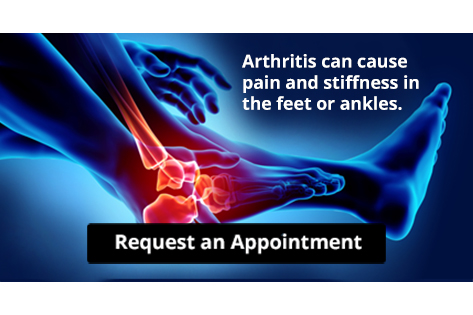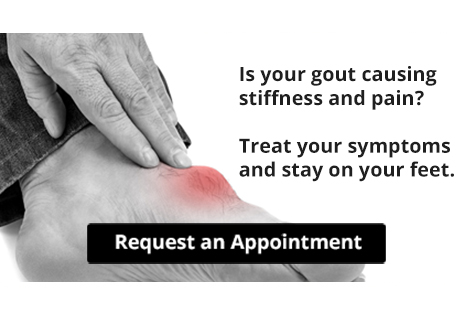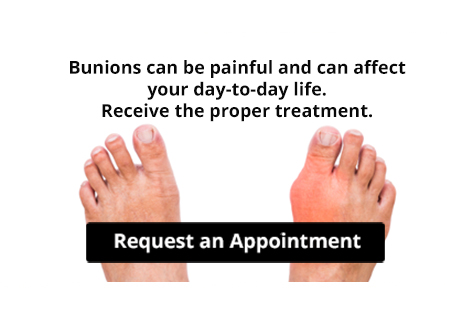Blog
Plantar Warts Can Be Treated!
Can Flat Feet Cause Pain?
 The medical term that is known as flat feet refers to feet that have an absent or low arch. The majority of babies are born without an arch, however it will generally develop as they enter their teenage years. This condition is noticeable when the foot lies completely on the floor. The foot will naturally turn inward in order to grip the floor, which may cause pain and discomfort. The Achilles tendon may become affected as a result of the position of the heel, and this may lead to difficulty with walking. Many patients have found relief when orthotics are worn, which may provide the support that is needed as daily tasks are completed. If you have flat feet, it is suggested that you consult with a podiatrist who can properly evaluate your condition, and recommend the best treatment option for you.
The medical term that is known as flat feet refers to feet that have an absent or low arch. The majority of babies are born without an arch, however it will generally develop as they enter their teenage years. This condition is noticeable when the foot lies completely on the floor. The foot will naturally turn inward in order to grip the floor, which may cause pain and discomfort. The Achilles tendon may become affected as a result of the position of the heel, and this may lead to difficulty with walking. Many patients have found relief when orthotics are worn, which may provide the support that is needed as daily tasks are completed. If you have flat feet, it is suggested that you consult with a podiatrist who can properly evaluate your condition, and recommend the best treatment option for you.
Flatfoot is a condition many people suffer from. If you have flat feet, contact Shaun J. Limon, DPM and Lisa Griffith-Limon, DPM from Limons Foot & Ankle Care. Our doctors will treat your foot and ankle needs.
What Are Flat Feet?
Flatfoot is a condition in which the arch of the foot is depressed and the sole of the foot is almost completely in contact with the ground. About 20-30% of the population generally has flat feet because their arches never formed during growth.
Conditions & Problems:
Having flat feet makes it difficult to run or walk because of the stress placed on the ankles.
Alignment – The general alignment of your legs can be disrupted, because the ankles move inward which can cause major discomfort.
Knees – If you have complications with your knees, flat feet can be a contributor to arthritis in that area.
Symptoms
- Pain around the heel or arch area
- Trouble standing on the tip toe
- Swelling around the inside of the ankle
- Flat look to one or both feet
- Having your shoes feel uneven when worn
Treatment
If you are experiencing pain and stress on the foot you may weaken the posterior tibial tendon, which runs around the inside of the ankle.
If you have any questions please feel free to contact our offices located in Bradenton and Lakewood Ranch, FL . We offer the newest diagnostic and treatment technologies for all your foot and ankle needs.
Read more about Flat FeetPossible Causes of an Ingrown Toenail
 The condition that is known as an ingrown toenail typically affects the big toe. It occurs as a result of the outer edges of the toenail growing into the skin. Patients who are afflicted with this ailment are often familiar with the pain and discomfort an ingrown toenail may cause. If the toenail is infected, there can be drainage oozing from the surrounding area. General reasons why ingrown toenails may develop can include trimming the nails incorrectly, or wearing shoes that do not have ample room for the toes to move freely in. Participating in certain sporting activities where trauma is placed on the toe may contribute to the formation of an ingrown toenail. If you have this condition, it is suggested that you consult with a podiatrist as quickly as possible who can guide you toward proper treatment techniques.
The condition that is known as an ingrown toenail typically affects the big toe. It occurs as a result of the outer edges of the toenail growing into the skin. Patients who are afflicted with this ailment are often familiar with the pain and discomfort an ingrown toenail may cause. If the toenail is infected, there can be drainage oozing from the surrounding area. General reasons why ingrown toenails may develop can include trimming the nails incorrectly, or wearing shoes that do not have ample room for the toes to move freely in. Participating in certain sporting activities where trauma is placed on the toe may contribute to the formation of an ingrown toenail. If you have this condition, it is suggested that you consult with a podiatrist as quickly as possible who can guide you toward proper treatment techniques.
Ingrown toenails can become painful if they are not treated properly. For more information about ingrown toenails, contact Shaun J. Limon, DPM and Lisa Griffith-Limon, DPM of Limons Foot & Ankle Care. Our doctors can provide the care you need to keep you pain-free and on your feet.
Ingrown Toenails
Ingrown toenails occur when a toenail grows sideways into the bed of the nail, causing pain, swelling, and possibly infection.
Causes
- Bacterial infections
- Improper nail cutting such as cutting it too short or not straight across
- Trauma to the toe, such as stubbing, which causes the nail to grow back irregularly
- Ill-fitting shoes that bunch the toes too close together
- Genetic predisposition
Prevention
Because ingrown toenails are not something found outside of shoe-wearing cultures, going barefoot as often as possible will decrease the likeliness of developing ingrown toenails. Wearing proper fitting shoes and using proper cutting techniques will also help decrease your risk of developing ingrown toenails.
Treatment
Ingrown toenails are a very treatable foot condition. In minor cases, soaking the affected area in salt or antibacterial soaps will not only help with the ingrown nail itself, but also help prevent any infections from occurring. In more severe cases, surgery is an option. In either case, speaking to your podiatrist about this condition will help you get a better understanding of specific treatment options that are right for you.
If you have any questions please feel free to contact our offices located in Bradenton and Lakewood Ranch, FL . We offer the newest diagnostic and treatment technologies for all your foot and ankle needs.
Read more about Ingrown Toenail CareArthritis Can Cause Pain in the Feet and Ankles
Common Types of Foot Pain
 The foot is comprised of numerous bones, tendons, and ligaments, and general foot pain may be felt as a result of body weight the feet endure on a daily basis. There are specific types of foot injuries that affect many patients. These can consist of tendon injuries, fractures, and sprains. Additionally, corns are caused by excess friction from wearing shoes and socks that do not fit properly, and may produce considerable pain and discomfort. A common type of toe pain may be related to ingrown toenails. This occurs when the nail on the big toe grows into the surrounding skin. If you are afflicted with any type of foot pain, it is strongly advised that you consult with a podiatrist who can offer the best remedy for the type of foot pain you may have.
The foot is comprised of numerous bones, tendons, and ligaments, and general foot pain may be felt as a result of body weight the feet endure on a daily basis. There are specific types of foot injuries that affect many patients. These can consist of tendon injuries, fractures, and sprains. Additionally, corns are caused by excess friction from wearing shoes and socks that do not fit properly, and may produce considerable pain and discomfort. A common type of toe pain may be related to ingrown toenails. This occurs when the nail on the big toe grows into the surrounding skin. If you are afflicted with any type of foot pain, it is strongly advised that you consult with a podiatrist who can offer the best remedy for the type of foot pain you may have.
Foot Pain
Foot pain can be extremely painful and debilitating. If you have a foot pain, consult with Shaun J. Limon, DPM and Lisa Griffith-Limon, DPM from Limons Foot & Ankle Care. Our doctors will assess your condition and provide you with quality foot and ankle treatment.
Causes
Foot pain is a very broad condition that could be caused by one or more ailments. The most common include:
- Bunions
- Hammertoes
- Plantar Fasciitis
- Bone Spurs
- Corns
- Tarsal Tunnel Syndrome
- Ingrown Toenails
- Arthritis (such as Gout, Rheumatoid, and Osteoarthritis)
- Flat Feet
- Injury (from stress fractures, broken toe, foot, ankle, Achilles tendon ruptures, and sprains)
- And more
Diagnosis
To figure out the cause of foot pain, podiatrists utilize several different methods. This can range from simple visual inspections and sensation tests to X-rays and MRI scans. Prior medical history, family medical history, and any recent physical traumatic events will all be taken into consideration for a proper diagnosis.
Treatment
Treatment depends upon the cause of the foot pain. Whether it is resting, staying off the foot, or having surgery; podiatrists have a number of treatment options available for foot pain.
If you have any questions, please feel free to contact our offices located in Bradenton and Lakewood Ranch, FL . We offer the newest diagnostic and treatment technologies for all your foot care needs.
Read more about Foot PainBunions May Require Surgery
 There are many reasons why a bunion may develop. This bony protrusion that can form on the side of the big toe can be the result of genetic factors, medical conditions that can include arthritis, or possibly from wearing shoes that do not fit correctly. These would include shoes that are snug in the toe area and may rub against the side of the big toe. A bunion is considered to be a bone deformity and a structural issue with the big toe. Many patients find that putting a pad over the bunion while wearing shoes may bring mild relief. In more severe cases, surgery may be a necessary option for permanent removal. This type of procedure is referred to as a bunionectomy. A common practice that may be helpful in preventing bunions from developing is wearing shoes that have ample room for the toes to move freely in. If you have developed a bunion, please consult with a podiatrist who can perform a proper diagnosis and offer treatment options.
There are many reasons why a bunion may develop. This bony protrusion that can form on the side of the big toe can be the result of genetic factors, medical conditions that can include arthritis, or possibly from wearing shoes that do not fit correctly. These would include shoes that are snug in the toe area and may rub against the side of the big toe. A bunion is considered to be a bone deformity and a structural issue with the big toe. Many patients find that putting a pad over the bunion while wearing shoes may bring mild relief. In more severe cases, surgery may be a necessary option for permanent removal. This type of procedure is referred to as a bunionectomy. A common practice that may be helpful in preventing bunions from developing is wearing shoes that have ample room for the toes to move freely in. If you have developed a bunion, please consult with a podiatrist who can perform a proper diagnosis and offer treatment options.
If you are suffering from bunion pain, contact Shaun J. Limon, DPM and Lisa Griffith-Limon, DPM of Limons Foot & Ankle Care. Our doctors can provide the care you need to keep you pain-free and on your feet.
What Is a Bunion?
Bunions are painful bony bumps that usually develop on the inside of the foot at the joint of the big toe. As the deformity increases over time, it may become painful to walk and wear shoes. Women are more likely to exacerbate existing bunions since they often wear tight, narrow shoes that shift their toes together. Bunion pain can be relieved by wearing wider shoes with enough room for the toes.
Causes
- Genetics – some people inherit feet that are more prone to bunion development
- Inflammatory Conditions - rheumatoid arthritis and polio may cause bunion development
Symptoms
- Redness and inflammation
- Pain and tenderness
- Callus or corns on the bump
- Restricted motion in the big toe
In order to diagnose your bunion, your podiatrist may ask about your medical history, symptoms, and general health. Your doctor might also order an x-ray to take a closer look at your feet. Nonsurgical treatment options include orthotics, padding, icing, changes in footwear, and medication. If nonsurgical treatments don’t alleviate your bunion pain, surgery may be necessary.
If you have any questions, please feel free to contact our offices located in Bradenton and Lakewood Ranch, FL . We offer the newest diagnostic and treatment technologies for all your foot care needs.
Read more about BunionsGout Pain Can Be Managed
Pregnancy, High Heels, and Flip Flops
 Recent studies that have been conducted in the United Kingdom indicate approximately half of pregnant women are influenced by society to keep up with the latest fashion trends. This consists of choosing to wear inappropriate shoes that include high heels and flip flops during the majority of their pregnancy. When these types of shoes are frequently worn, the risk of falling may increase. This may be a result of hormonal changes that occur within the body, causing the ligaments and muscles to stretch and become soft. Pregnant women may feel more secure when flip flops are avoided, and shoes with a lower heel are worn. It is beneficial to choose shoes that have the proper amount of cushioning, as this is often helpful in providing adequate support. If you would like additional information about how to choose the correct shoes to be worn during pregnancy, please consult with a podiatrist.
Recent studies that have been conducted in the United Kingdom indicate approximately half of pregnant women are influenced by society to keep up with the latest fashion trends. This consists of choosing to wear inappropriate shoes that include high heels and flip flops during the majority of their pregnancy. When these types of shoes are frequently worn, the risk of falling may increase. This may be a result of hormonal changes that occur within the body, causing the ligaments and muscles to stretch and become soft. Pregnant women may feel more secure when flip flops are avoided, and shoes with a lower heel are worn. It is beneficial to choose shoes that have the proper amount of cushioning, as this is often helpful in providing adequate support. If you would like additional information about how to choose the correct shoes to be worn during pregnancy, please consult with a podiatrist.
Pregnant women with swollen feet can be treated with a variety of different methods that are readily available. For more information about other cures for swollen feet during pregnancy, consult with Shaun J. Limon, DPM and Lisa Griffith-Limon, DPM from Limons Foot & Ankle Care. Our doctors will attend to all of your foot and ankle needs.
What Foot Problems Can Arise During Pregnancy?
One problem that can occur is overpronation, which occurs when the arch of the foot flattens and tends to roll inward. This can cause pain and discomfort in your heels while you’re walking or even just standing up, trying to support your baby.
Another problem is edema, or swelling in the extremities. This often affects the feet during pregnancy but tends to occur in the later stages.
How Can I Keep My Feet Healthy During Pregnancy?
- Wearing orthotics can provide extra support for the feet and help distribute weight evenly
- Minimize the amount of time spent walking barefoot
- Wear shoes with good arch support
- Wear shoes that allow for good circulation to the feet
- Elevate feet if you experience swelling
- Massage your feet
- Get regular, light exercise, such as walking, to promote blood circulation to the feet
If you have any questions please feel free to contact our offices located in Bradenton and Lakewood Ranch, FL . We offer the newest diagnostic and treatment technologies for all your foot and ankle needs.
Read more about Pregnancy and Foot HealthPossible Causes of Poor Circulation
 Research has indicated that if you have poor circulation in your feet, it may be indicative of other medical conditions. These may include diabetes, heart conditions, and obesity. It is defined as restricted blood flow to the lower extremities, and there are often noticeable symptoms that are associated with this condition. These can consist of numbness, tingling, and muscle cramps, in addition to pain and discomfort. Nerve damage can possibly be caused by poor circulation, in addition to varicose veins and blood clots. Patients may find relief when specific exercises are performed, and compression stockings are worn that are designed for painful, swollen legs. If you feel you have symptoms of this condition, it is advised that you consult with a podiatrist to learn about the best treatment options for you.
Research has indicated that if you have poor circulation in your feet, it may be indicative of other medical conditions. These may include diabetes, heart conditions, and obesity. It is defined as restricted blood flow to the lower extremities, and there are often noticeable symptoms that are associated with this condition. These can consist of numbness, tingling, and muscle cramps, in addition to pain and discomfort. Nerve damage can possibly be caused by poor circulation, in addition to varicose veins and blood clots. Patients may find relief when specific exercises are performed, and compression stockings are worn that are designed for painful, swollen legs. If you feel you have symptoms of this condition, it is advised that you consult with a podiatrist to learn about the best treatment options for you.
Poor circulation is a serious condition and needs immediate medical attention. If you have any concerns with poor circulation in your feet contact Shaun J. Limon, DPM and Lisa Griffith-Limon, DPM of Limons Foot & Ankle Care. Our doctors will treat your foot and ankle needs.
Poor Circulation in the Feet
Poor blood circulation in the feet and legs is can be caused by peripheral artery disease (PAD), which is the result of a buildup of plaque in the arteries.
Plaque buildup or atherosclerosis results from excess calcium and cholesterol in the bloodstream. This can restrict the amount of blood which can flow through the arteries. Poor blood circulation in the feet and legs are sometimes caused by inflammation in the blood vessels, known as vasculitis.
Causes
Lack of oxygen and oxygen from poor blood circulation restricts muscle growth and development. It can also cause:
- Muscle pain, stiffness, or weakness
- Numbness or cramping in the legs
- Skin discoloration
- Slower nail & hair growth
- Erectile dysfunction
Those who have diabetes or smoke are at greatest risk for poor circulation, as are those who are over 50. If you have poor circulation in the feet and legs it may be caused by PAD and is important to make changes to your lifestyle in order to reduce risk of getting a heart attack or stroke. Exercise and maintaining a healthy lifestyle will dramatically improve conditions.
As always, see a podiatrist as he or she will assist in finding a regimen that suits you. A podiatrist can also prescribe you any needed medication.
If you have any questions please feel free to contact our offices located in Bradenton and Lakewood Ranch, FL . We offer the newest diagnostic and treatment technologies for all your foot and ankle needs.
Read more about Causes, Symptoms, and Treatment of Poor Blood Circulation in the FeetAre Bunions Affecting Your Everyday Life?
More...
Symptoms Of An Achilles Tendon Injury
The Achilles tendon connects the heel to the calf muscles, and it is located in the back of the leg, directly above the heel. It is known to be the largest tendon in the body, and if it should become injured, it may be difficult to walk and run. This tendon enables the foot to point and flex, in addition to standing on tiptoe. There are noticeable symptoms that exist if an Achilles tendon injury has occurred. These can include severe pain in the back of the leg, the inability to bend the foot, and some patients may also notice the ankle is bruised and weak. As the aging process occurs, it is important to perform proper stretches that can keep the Achilles tendon strong, and this may be helpful in preventing a painful injury from occurring. It can become torn or injured if you suddenly step off of a curb, which may overstretch the tendon. Moderate relief may be found when the affected foot is elevated, and it may feel comforting if an elastic bandage is wrapped around the foot to provide additional support. If you have injured your Achilles tendon, it is advised that you consult with a podiatrist who can properly treat this condition.
Achilles tendon injuries need immediate attention to avoid future complications. If you have any concerns, contact Shaun J. Limon, DPM and Lisa Griffith-Limon, DPM of Limons Foot & Ankle Care. Our doctors can provide the care you need to keep you pain-free and on your feet.
What Is the Achilles Tendon?
The Achilles tendon is a tendon that connects the lower leg muscles and calf to the heel of the foot. It is the strongest tendon in the human body and is essential for making movement possible. Because this tendon is such an integral part of the body, any injuries to it can create immense difficulties and should immediately be presented to a doctor.
What Are the Symptoms of an Achilles Tendon Injury?
There are various types of injuries that can affect the Achilles tendon. The two most common injuries are Achilles tendinitis and ruptures of the tendon.
Achilles Tendinitis Symptoms
- Inflammation
- Dull to severe pain
- Increased blood flow to the tendon
- Thickening of the tendon
Rupture Symptoms
- Extreme pain and swelling in the foot
- Total immobility
Treatment and Prevention
Achilles tendon injuries are diagnosed by a thorough physical evaluation, which can include an MRI. Treatment involves rest, physical therapy, and in some cases, surgery. However, various preventative measures can be taken to avoid these injuries, such as:
- Thorough stretching of the tendon before and after exercise
- Strengthening exercises like calf raises, squats, leg curls, leg extensions, leg raises, lunges, and leg presses
If you have any questions please feel free to contact our offices located in Bradenton and Lakewood Ranch, FL . We offer the newest diagnostic tools and technology to treat your foot and ankle needs.
Read more about Achilles Tendon InjuriesPossible Causes of Blisters
Friction is typically the principal cause of blisters on the feet. They can occur from wearing shoes that do not fit properly, which may cause rubbing against the heel or toes. Additionally, they can also form as an allergic reaction to an insect bite, or from severe sunburn or frostbite. They are defined as small bubble-like areas that are filled with clear fluid which protects the damaged skin. It generally drains naturally, as the skin heals and is replaced by new skin. If the blister should become infected, the fluid may be filled with pus or blood, and should be treated immediately. It is helpful to put a covering over the blister while wearing shoes, as this may help to protect the blister as much as possible while the healing process begins. If you frequently get blisters on the feet, it is advised that you speak to a podiatrist who can offer proper treatment options.
Blisters are prone to making everyday activities extremely uncomfortable. If your feet are hurting, contact Shaun J. Limon, DPM and Lisa Griffith-Limon, DPM of Limons Foot & Ankle Care. Our doctors can provide the care you need to keep you pain-free and on your feet.
Foot Blisters
Foot blisters develop as a result of constantly wearing tight or ill-fitting footwear. This happens due to the constant rubbing from the shoe, which can often lead to pain.
What Are Foot Blisters?
A foot blister is a small fluid-filled pocket that forms on the upper-most layer of the skin. Blisters are filled with clear fluid and can lead to blood drainage or pus if the area becomes infected.
How Do Blisters Form?
Blisters on the feet are often the result of constant friction of skin and material, usually by shoe rubbing. Walking in sandals, boots, or shoes that don’t fit properly for long periods of time can result in a blister. Having consistent foot moisture and humidity can easily lead to blister formation.
Prevention & Treatment
It is important to properly care for the affected area in order to prevent infection and ease the pain. Do not lance the blister and use a Band-Aid to provide pain relief. Also, be sure to keep your feet dry and wear proper fitting shoes. If you see blood or pus in a blister, seek assistance from a podiatrist.
If you have any questions, please feel free to contact our offices located in Bradenton and Lakewood Ranch, FL . We offer the newest diagnostic and treatment technologies for all your foot care needs.
Read more about BlistersAre You Suffering From Ingrown Toenails?
Why Does Foot Pain Occur?
 Traumas, diseases, and injuries are among the common causes of foot pain. There are numerous muscles, joints, and ligaments each foot is comprised of, in addition to bands of tissue that absorb shock while walking or participating in sporting activities. The symptoms that are often associated with foot pain can include pain and discomfort in the ankle, difficulty in pointing and flexing the foot, and the foot may feel stiff and weak. There are many working parts to the foot, and the overall structure may be affected if part of the foot should become injured. When pain in the arch exists, it may be indicative of plantar fasciitis. This condition affects the portion of tissue that connects the heel to the toes. If pain is noticed in the top of the foot, Morton’s neuroma may exist. Pain in the big toe and surrounding area may be consistent with a form of arthritis that is known as gout. If you are experiencing any type of pain that affects the feet, it is strongly advised that you consult with a podiatrist who can diagnosis and treat foot pain.
Traumas, diseases, and injuries are among the common causes of foot pain. There are numerous muscles, joints, and ligaments each foot is comprised of, in addition to bands of tissue that absorb shock while walking or participating in sporting activities. The symptoms that are often associated with foot pain can include pain and discomfort in the ankle, difficulty in pointing and flexing the foot, and the foot may feel stiff and weak. There are many working parts to the foot, and the overall structure may be affected if part of the foot should become injured. When pain in the arch exists, it may be indicative of plantar fasciitis. This condition affects the portion of tissue that connects the heel to the toes. If pain is noticed in the top of the foot, Morton’s neuroma may exist. Pain in the big toe and surrounding area may be consistent with a form of arthritis that is known as gout. If you are experiencing any type of pain that affects the feet, it is strongly advised that you consult with a podiatrist who can diagnosis and treat foot pain.
Foot Pain
Foot pain can be extremely painful and debilitating. If you have a foot pain, consult with Shaun J. Limon, DPM and Lisa Griffith-Limon, DPM from Limons Foot & Ankle Care. Our doctors will assess your condition and provide you with quality foot and ankle treatment.
Causes
Foot pain is a very broad condition that could be caused by one or more ailments. The most common include:
- Bunions
- Hammertoes
- Plantar Fasciitis
- Bone Spurs
- Corns
- Tarsal Tunnel Syndrome
- Ingrown Toenails
- Arthritis (such as Gout, Rheumatoid, and Osteoarthritis)
- Flat Feet
- Injury (from stress fractures, broken toe, foot, ankle, Achilles tendon ruptures, and sprains)
- And more
Diagnosis
To figure out the cause of foot pain, podiatrists utilize several different methods. This can range from simple visual inspections and sensation tests to X-rays and MRI scans. Prior medical history, family medical history, and any recent physical traumatic events will all be taken into consideration for a proper diagnosis.
Treatment
Treatment depends upon the cause of the foot pain. Whether it is resting, staying off the foot, or having surgery; podiatrists have a number of treatment options available for foot pain.
If you have any questions, please feel free to contact our offices located in Bradenton and Lakewood Ranch, FL . We offer the newest diagnostic and treatment technologies for all your foot care needs.
Read more about Foot Pain






